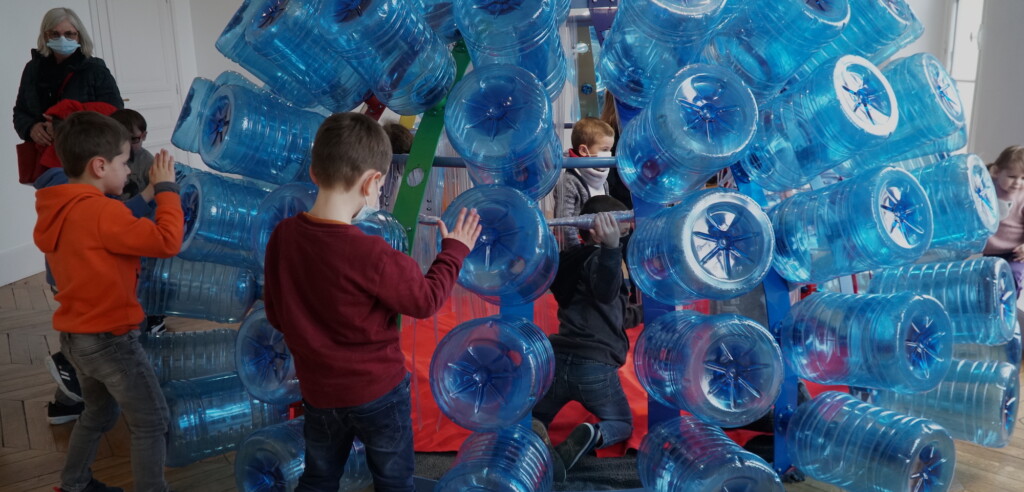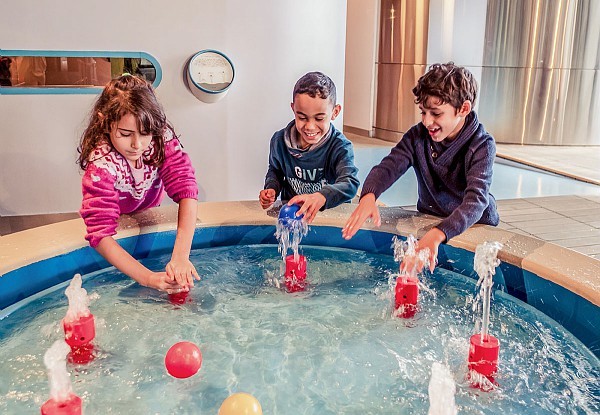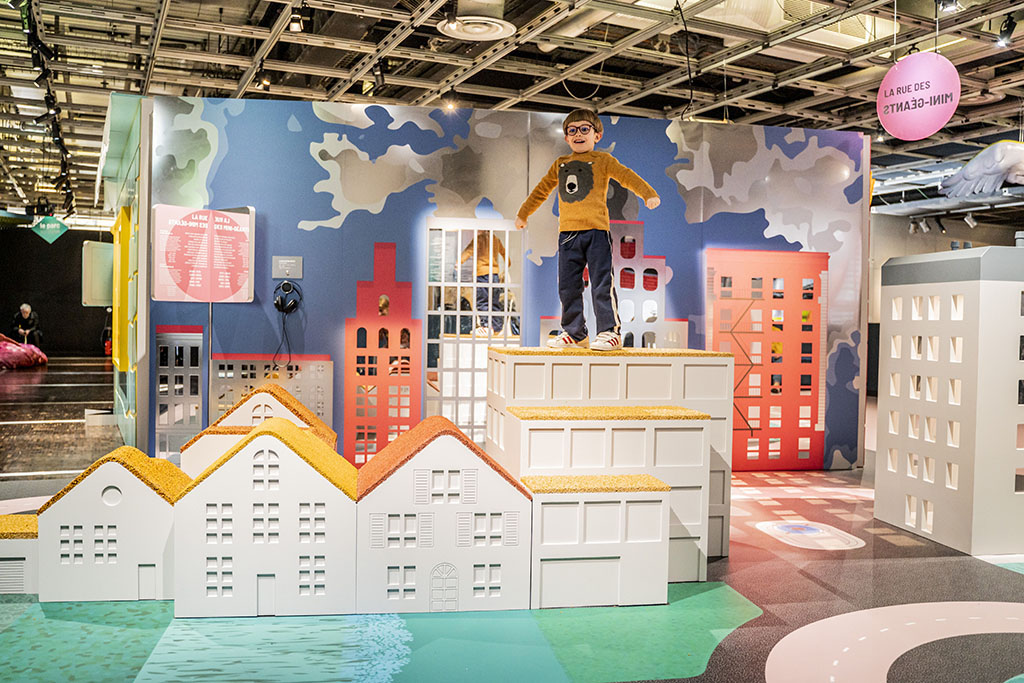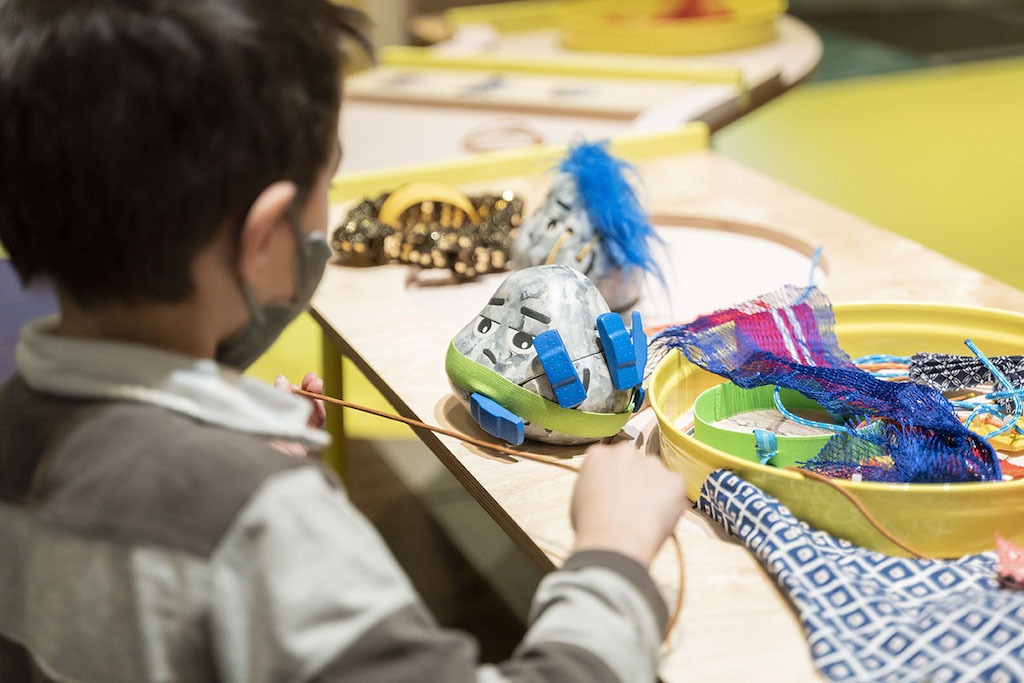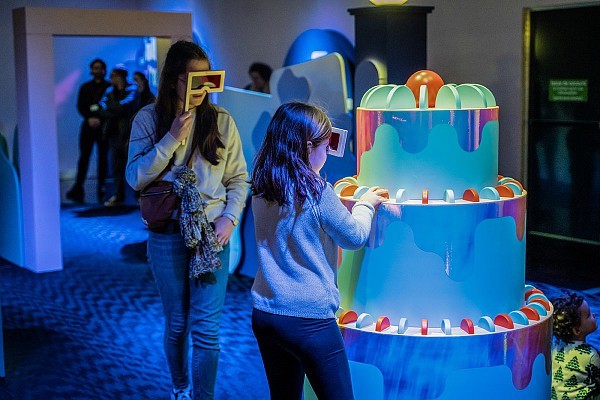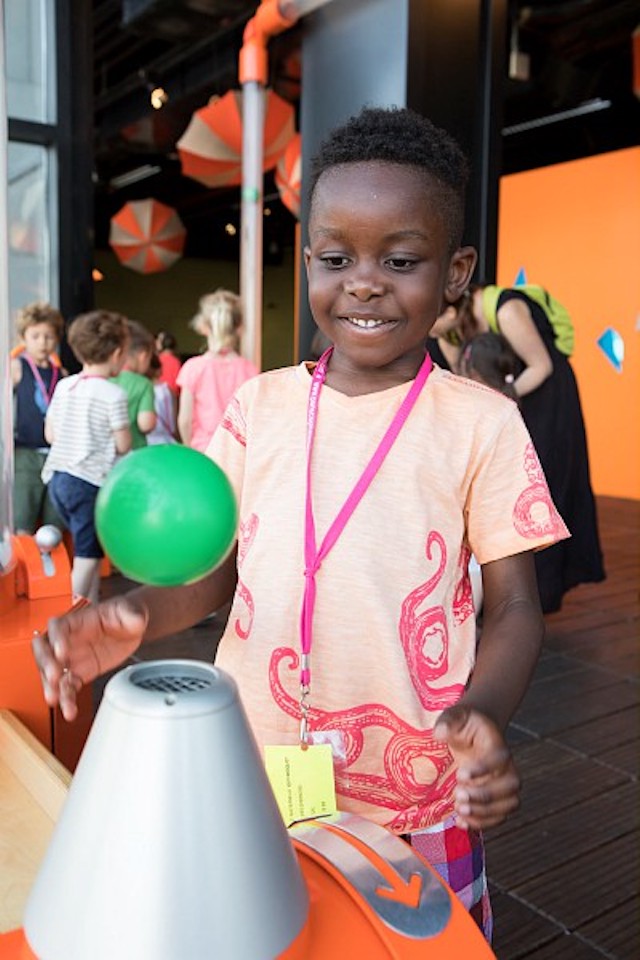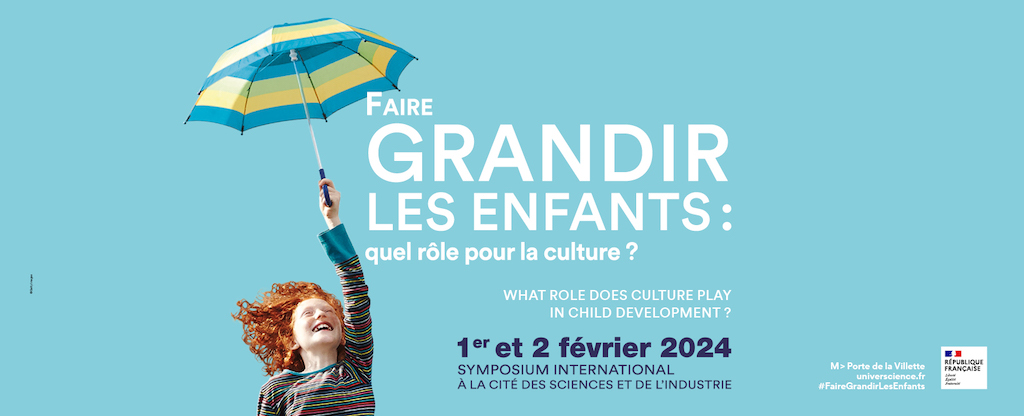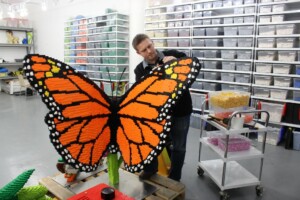At the Cité des sciences et de l’industrie, young museum-goers can enjoy a carnival, explore a forest, work in a factory, and become hosts in a TV studio – all in one day. Thanks to the significant experience of its overseeing company, Universcience, an organisation that works to make science accessible to all, children’s exhibitions and experiences are all the rage at the Parisian destination.
Universcience’s expertise in children’s exhibitions
The Cité des enfants is a testament to Universcience’s skill in creating durable and engaging participative and educational experiences for children of all ages. Located at the Cité des sciences et de l’industrie, it is a permanent space. It provides a place for children between the ages of 2 and 12 to play, explore, and create lasting memories.
Containing over 240 exhibition elements, the Cité des enfants includes two spaces. One is for children between the ages of 2-7, while the other is for children between 5 and 12.
Younger visitors can discover spaces that invite self-discovery. From building to experimenting, five zones give children and those accompanying them the opportunity to learn actively, and at their own pace. Older children can delve into different learning experiences across six spaces. These allow them to self-direct their learning process and encourage their curiosity through interactive games and many areas of exploration.
The Cité des enfants
Created in 1992, the Cité des enfants was a pioneer in creating museum spaces dedicated to children and their development. Since then, it has seen over 15 million visitors, with 733,000 coming to enjoy the space in 2022. Just last year, when celebrating its 30th anniversary, the Cité des sciences et de l’industrie welcomed over 30,000 guests in one festive weekend full of workshops, group experiences, and new and exciting activities. This proves that the Cité des sciences et de l’industrie is only growing in popularity and innovation.
The benefits loom large in the memories of its “old” visitors – adults who remember visiting as children. In a study of these former visitors to the space, many discussed the happy memories of their visits. They also shared stories about its impact on their adult lives.
Universcience president Bruno Maquart pointed to these recent successes as proof of the competence of the Universcience brand:
“Having welcomed so many generations of loyal visitors to this emblematic and acclaimed space since its inception reflects the expertise of this establishment in terms of museography and programming for children.”
A history of successful product design
At Universcience, the drive to create educational and playful museum spaces centred around children is an international affair. In 2018, Universcience started the editorial line “Young and Curious/Elementary Science,” a series of temporary and touring exhibitions centred around children.
Drawing upon the success of the Cité des enfants, Maquart noted that the goal of this series was to create new environments for children to mix exploration with education – and to share this worldwide. “It gives young children a unique opportunity to relish the joys of discovery while stimulating their creativity,” he explained.
In these projects, Universcience aims to combine its expertise in children’s programming with the latest developments in educational science.
The first exhibition in this project, Playhuts, was on display from December 2018 to January 2020. Divided into two sections – play huts to explore and play huts to create – this novel exhibition seamlessly integrated child education and development into a fun, exploratory, and active environment. By giving visitors the chance to build huts themselves after learning about them, Playhuts presents children with the opportunity to apply new knowledge to open-ended challenges, without predetermined answers and almost no text.
Highlights of the exhibition included entering a hut designed with books and a photo wall depicting the huts of different cultures. There was also the challenge zone, where children became engineers in a hut-building lab. Since its run in Paris, Playhuts has gone on to amuse and educate visitors to the Château Chanorier in Croissy-sur-Seine, France.
The tools for creating an engaging visit: the power of imagination
To engage young visitors, Universcience’s curators are bursting with imagination and inventiveness, sharing new concepts and stories in ever more surprising ways. They create new worlds or characters for the children to discover. Opposites, the second exhibition in the “Young and Curious/Elementary Science” series, which opened in 2020, is a great example.
Tall/small, high/low, light or dark… Through contrasting perceptions, the child develops reference points and boundaries. Within these, they will gradually be able to introduce a range of sensations, emotions and ideas that are increasingly refined and nuanced. Unusual and poetic, the exhibition immerses visitors aged 2 to 7 and their accompanying adults in an imaginary world of contrasting visual, sound, and tactile perceptions.
In this unusual village, the exhibition reinvents familiar childhood places – home, school, park, shop, street – in a sensory, visual, and joyful way. Both poetic and funny, the design of Opposites stimulates the body and the senses.
Children discover an unusual village made up of five spaces. These are the faded house, the kooky school, the park in the sky, the mini giants street and the neat bazaar. As they wander through this imaginary world, young visitors will have all their senses on alert. These transformed everyday places feature pairs of opposites in strange and eccentric settings. There are many activities that guests can discover amidst the architecture, furniture, objects, and so on.
Fragile!
Meanwhile, in 2022, for the first time at the Cité des sciences et de l’industrie, the curator of the exhibition Fragile! and the designers developed an exhibition that works like a story featuring little characters created for this occasion. This exhibition invited children and their parents to travel the tiny world of Windy, Iggy, Folia, Glitch, Woolma and Roky – who were a balloon, an egg, a sheet of paper, a bar of soap, a ball of wool and a stone.
These six endearing characters will take children on multiple adventures and will lead them to discover the concept of fragility. Handling fragile objects, testing delicate materials, experimenting with falling and feeling vulnerable: young visitors explore this complex yet vital notion.
Visitors discover and experience the Fragile! exhibition through storytelling. Moving from chapter to chapter alongside the little characters, children can handle, experiment and discover the concept of fragility with many different objects, decors and installations.
Currently on display
In April 2023, Universcience opened its newest temporary children’s exhibition at the Cité des sciences et de l’industrie. Metamorphoses is an exhibition consisting of five immersive universes.
It is designed to allow visitors to interact with shifting worlds – and discover transformations within themselves. Childhood is a time of change and transformation. The exhibition invites young visitors to think about their own existence and relation to time and its passing.
This exhibition caters to a new and wider age group, from 6 to 11 years old. Therefore, it is different from that of Universcience’s previous children’s exhibitions (Playhuts and Opposites). The curators were also joined by a group of 12 children. This panel put forward the desires of young visitors and added a personal touch to the exhibition.
While it is an immersive and playful experience for children, it remains scientifically serious and educational. The term “metamorphoses” holds multiple meanings. In biology, it refers to an important and irreversible transformation during an organism’s development. Or, in common tongue, it can mean any change.
A thought-provoking children’s exhibition
The exhibition highlights and explores these nuances by creating a conversation on different topics through participative experiences. For example, in the section of the exhibit titled Mirror, Mirror on the wall, young visitors are faced with different elements which transform their appearance right in front of their eyes. These exhibit elements raise important questions about the nature of one’s identity, how outward perception contributes to their understanding of themselves and the degree to which their presentation to others affects them in an easy-to-understand way.
Metamorphoses also draws upon both popular and not as well-known stories and cultural references to bring these themes to life. Invoking references to Alice in Wonderland and myths from Ovid’s Metamorphoses throughout the different exhibit elements helps to ground the experience in the context of tales with which children are already familiar. This gives a cohesive sense to the exhibition as a whole.
Yet Metamorphoses also introduces unfamiliar stories such as that of Xolotl from the Aztec culture in Mexico. Throughout the space, these elements work together to allow visitors to learn through experience, internalising the undercurrent of the world around us: change.
The future of Universcience’s children’s exhibitions
The next temporary exhibition for Universcience will be its biggest project yet. Opening in July 2024, Dance measures 800 m2. It will turn the Cité des sciences et de l’industrie into a ballroom, and dance studio, all in one. The exhibition is being created for children and their families, allowing the Cité des sciences et de l’industrie to continue to welcome its youngest audiences while the Cité des enfants closes for renovations in 2024 and 2025.
This new exhibit will use dance as an action to be enjoyed and a state of being to be studied. It will encourage children and their families to explore the world around them, discover a relationship between the individual and the collective, develop a sense of self, and interrogate the beauty in movement. The theme is a natural choice for a children’s offer. Dance is one of the earliest forms of self-expression that a child develops.
To create an environment where visitors can share moments of joy, give in to their instinct to move, and explore their relationship to dance culture, the exhibition will be built to highlight four different movements in dancing: jumping, turning, walking, and encountering others. Each verb will have a self-contained space devoted to its exploration within the gallery space.
In the centre, visitors will meet at a ball every 45 minutes. Here, they will be guided through three types of collective dances. This exhibition will allow visitors to think about the idea of dance through a diverse array of participatory and passive spaces. All parts will work together to create a collective dance experience promoting connection and discovery.
Dance will be available in a reduced format for touring. It is expected to begin its touring cycle at the end of 2025.
Renewing the Children’s City
One of Universcience’s flagship upcoming projects is the renewal of the Children’s City in 2024 and 2025. Society, the world and the way children take part in it have changed enormously in recent years. The Cité des enfants must also evolve towards a new, ambitious and reinvented proposition. This new Cité des enfants will be committed, rooted in the real world and in tune with the challenges of tomorrow.
Thanks to audience research carried out over the last decades and the museography experiments of the editorial line “Young and curious/ Elementary Science”, Universcience has highlighted the strengths and weaknesses of the Cité des enfants.
The idea is not to get rid of everything that has been a success over the past 30 years. Instead, the team will take what the public likes, update it and add new areas for the children of today and tomorrow, for hopefully the next 30 years or more! Even if the venue wants to renew its permanent exhibition spaces, there’s no question of starting from scratch, but rather of enhancing its greatest successes.
The essential elements will be taken up again (adapting them if necessary) and also complemented by new highlights incorporating a more open, modernized museography. Just as plants grow and develop, without losing their old leaves.
In line with all of Universcience’s museography projects for children, a visit to the future Cité des enfants will equip children to develop a better understanding of themselves, of others and of the world around them.
Combining years of experience with cutting-edge innovation
With over 30 years of experience in the world of children’s museography – and indeed as one of its pioneers – Universcience brings expertise and knowledge to every new exhibition it designs. However, the brand is not complacent in its development. It is also constantly searching for new ways to create better experiences for its young visitors.
Each exhibition is carefully designed to encourage learning on complex and important subjects. But this is always done in a fun and participative environment. Universcience aims to inspire each child who passes through its exhibition to become a leader in their own education. It wants them to get excited about the process of discovery and development.
Universcience will be hosting an event for museum and children professionals next year. An international symposium, “What role does culture play in child development?”, will take place on 1 – 2 February 2024.
The cultural offer for children evolves rapidly, as does our society. This is an opportunity for professionals in the industry to put their heads together to find new ways of supporting the development of children aged 2 to 10 so that they can flourish and meet the challenges ahead.
The first day of the symposium will look at children from various perspectives and ask how they fit into the museums and science centres of the future. Then, the second day of the conference invites attendees to question the worldviews they pass on to children through the stories they tell.
For more information and to register, free of charge, please click here.
